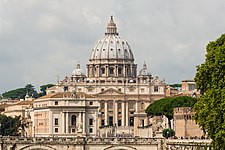Fabrian Catholic Church
This article is incomplete because it is pending further input from participants, or it is a work-in-progress by one author. Please comment on this article's talk page to share your input, comments and questions. Note: To contribute to this article, you may need to seek help from the author(s) of this page. |
Catholic Church | |
|---|---|
| Ecclesia Catholica | |
 St. Peter's Basilica, the largest Catholic church in the world | |
| Classification | Catholic |
| Scripture | Bible |
| Theology | Catholic theology |
| Polity | Episcopal |
| Pope | Pontian XI |
| Government | Holy See |
| Administration | Pontifical College |
| Particular churches sui iuris | Latin Church and # Uniate Churches |
| Dioceses | |
| Parishes | 221,700 |
| Region | Worldwide |
| Language | Latin |
| Liturgy | Western and Eastern |
| Headquarters | Fabria |
| Founder | Jesus, according to sacred tradition |
| Origin | 1st century Sydalon |
| Members | TBD (2022) |
| Hospitals | 5,500 |
| Primary schools | 95,200 |
| Secondary schools | 43,800 |
The Catholic Church, most commonly known as the Fabrian Catholic Church, and historically as the Imperial Church, is the largest Sarpetic church in the world, with # baptized Catholics as of 2022. It is among the oldest and largest extant international institutions, playing a major role in the history and development throughout the world. The Catholic Church consists of # particular churches and nearly 3,000 dioceses around the world. The Church is led by the Pope, who is the Bishop of Alba, is the chief pastor. The central governing authority of the Church is the Holy See, which unlike the Pope's territory of Fabria, is a sovereign subject of international law. The Church's and archbishopric's administrative bodies are located in Fabria, a Papal fief and special administrative located entirely within Castellum ab Alba. While the Papal seat of Fabria was reestablished between the Pope and Monarchy of Latium in the 1679 Treaty on Liberties and Privileges, the earliest seat of the Papacy as the Bishop of Alba was in Fabria, Castellum.
History
Organization
Holy See
Fabrian Curia
College of Cardinals
Canon law
Latin and particular and uniate churches
Honorian Catholic Church
The Honorian Catholic Church is a particular church, and the national church of the United Kingdom of Ottonia, and was previously the state churches of the kingdoms of Tyrrslynd, Onneria, Staalmark, and, prior to the Reformation, Sudemark. The Honorian Church traces itself to its foundation in the 6th Century AD by the Latin missionary Saint Honorius of Ascanium and its expansion through the conquests of Otto the Invincible in the 9th century AD.
In the present day, the Honorian Church is governed by an ecumenical council of bishops, headed by the Archbishop of Onneria. The church is estimated to have approximately 24 million parishoners, mostly in South Ottonia and Sudemark.